Feldpraktika-Impressionen
Stadt und/oder Natur?
Im Sommersemester 2025 beschäftigen sich BA Studierende des Feldpraktikums "Stadt und/oder Natur?" unter der Leitung von Sabrina Steindl-Kopf mit der Frage, wie Natur – ihre Gestaltung und Nutzung – in Wien verhandelt wird. Das Feldpraktikum öffnet damit den Blick auf die Vielfältigkeit von Perspektiven, Erfahrungen und Praktiken rund um städtische Lebensräume.
Die Studierenden teilen sich im Zuge des Feldpraktikums in Gruppen zu den Themenschwerpunkten:
- Nachhaltigkeit - Lebensmittel
- Nachhaltigkeit - Mode
- Stadtpark
- Gemeinschaftsgarten

Unter dem Aspekt der Nachhaltigkeit forschten Studierende zu Lebensmittelrettung und -verschwendung.
© Marilen Haas

In ihrer Forschung nahmen Studierende unterschiedliche Strategien der Lebensmittelrettung, wie etwa Sozialmärkte, in den Blick.
© Marilen Haas

Wie werden im dicht verbauten urbanen Raum Grünflächen genutzt? Dieser Frage widmeten sich Studierende am Beispiel des Stadtparks.
© Susanne Hickel

Gemeinschaftsgärten als Orte sozialer Aushandlungsprozesse untersuchten Studierende im Alsergarten und Sophiengarten.
© Barbara Rest

In ihrer Forschung zeigte sich, dass Fragen des Zugangs zu diesen Orten, die sich als „öffentlich“ verstehen, sehr unterschiedlich ausgehandelt werden.
© Barbara Rest

Der Aspekt der Nachhaltigkeit interessierte auch Studierende, die die Wiederverwertung von Kleidung untersuchten.
© Nina Marek

In ihrer Forschung widmeten sich die Studierenden der Nutzung von Flohmärkten und Second-Hand Läden...
© Klara Pilgram

… und nahmen auch die Bedeutung von Fast Fashion in den Blick.
© Engin Alkan

Mensch-Natur Beziehungen standen im Mittelpunkt des Interesses von Studierenden, die die City Farm im Augarten untersuchten.
© Kat Traußnig

In ihrer Forschung legten die Studierenden selbst Hand an und pflanzten Gemüse an.
© Kat Traußnig
Field school Alaska
Under the supervision of Peter Schweitzer and Olga Povoroznyuk nine MA students spend three weeks in Alaska where they have the opportunity to conduct short-term fieldwork. The journey takes them through four key locations: Anchorage, Kodiak Island, Talkeetna/Denali National Park, and Fairbanks. They explore cultural, historical, and ecological sites, connecting anthropological research with the lived environments of the Far North.
- field stay: 03.-25.03.2025
- related projects to this field school:
InfraNorth
ARCA

At the airport in Anchorage, Alaska - waiting for our flight to Kodiak.
© Julia Elzea

On Kodiak we visited the Department of Fish & Games - we got a tour through the facility and had the chance to look at the "Bear Sealing Room". Hunting rules on Kodiak are very strict. You need a permit, the chances to get one are very rare. But still: hunters kill about 180 Kodiak bears each year under tightly controlled regulations. And as soon as a bear has been shot, the skull will be measured in this room - to examine the bears age, health, weight,... When we arrived to this room, they were just cleaning up (we just missed the examination process and the chance to see a dead Kodiak-Bear).
© Julia Elzea

At the Alaska Department of Fish and Game on Kodiak, cultural and historical classes and talks were held, to deepen understanding of the island’s rich and complex Indigenous heritage. Traditional ecological knowledge, and the long-standing relationship between people, wildlife, and the environment.
© Julia Elzea

On a Kodiak-City Tour, explaining Kodiaks history and connection with fishing, religion and environment.
© Julia Elzea
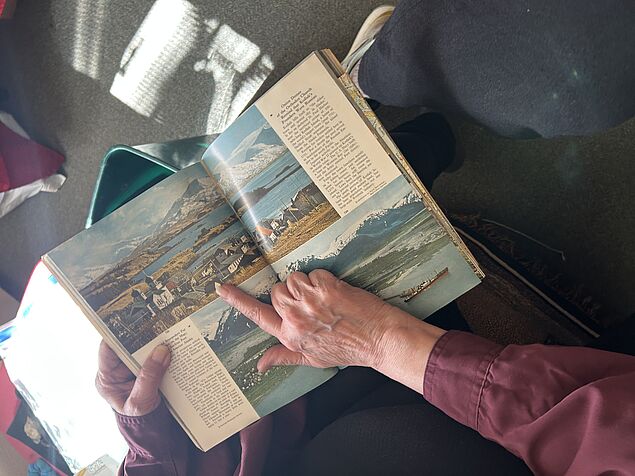
Raised in Kodiak, JoAnn Holmes comes from a Shumigan Island Unangam family. As an artist, she gathers local plants to make healing salves and tinctures. In addition, she creates bentwood visors and makes jewelry using antique Russian trade beads.
During an Interview with her, she pulled out an old "National Geographic Magazine" from June, 1956. Her mother read it to her, when she was a child. It reminds her of her childhood. There is an article about Downtown Kodiak in the Magazine. She shows me the pictures and remembers her life.
© Julia Elzea
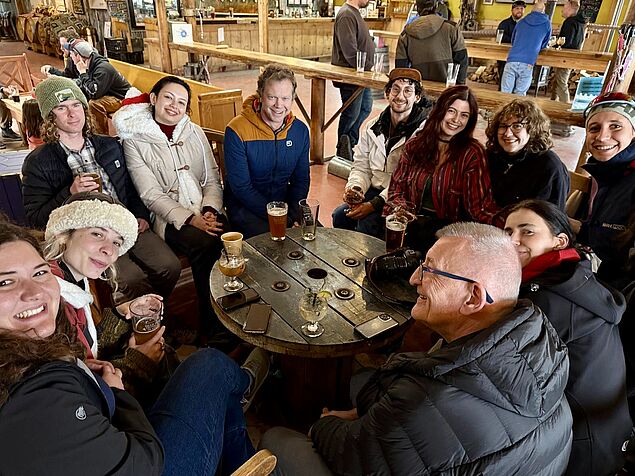
This photo was taken in the town of Kodiak, at a local spot called Kodiak Island Brewing Co. We gathered there for a relaxed drink with the whole group before heading to dinner, enjoying the cozy atmosphere and a chance to unwind together.
© Federica Pescador

Group-Hike at the Fort Abercrombie State Historical Park, located on Kodiak Island, Alaska. The park offers various trails, including the popular Fort Abercrombie Cliffs Loop. Beautiful landscapes and so much moss everywhere!
© Hannah Bösl

Visit at NOAA, Alaska Fisheries Science Center Kodiak Laboratory allowed us students to get aquainted with aquaculture.
© Hannah Bösl

Kodiak Island
© Oliwia Pordzik

This photo was taken by our guide during a walk through the forest in Fort Abercrombie, on Kodiak Island. The scenery was absolutely breathtaking — a mix of towering trees, soft forest light, and the quiet presence of nature all around us. As we walked, our guide shared stories about the landscape, the local plants, and the history of the area, making the experience both peaceful and deeply enriching.

Comparing a human Hand (Julia Eleza) next to a Bear-paw-print on a trail in Denali National Park.
© Hannah Bösl
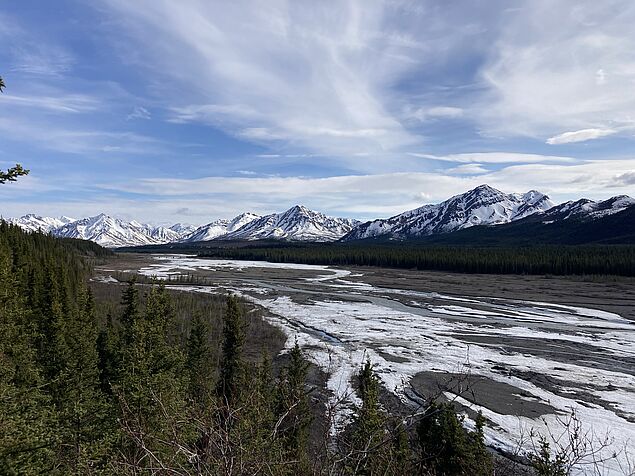
Denali National Park
© Hannah Bösl

Educational Trail Signage, Anchorage
© Klara Gmeinbauer

Musician Ed Washington @midnightson_music speaking with me via Zoom about his music, the Anchorage music scene, and his role as a mentor. I was especially grateful for the opportunity to talk to him, as several other Anchorage artists had mentioned him as a key figure and someone who supports fellow musicians and is considered a veteran of the local scene.
© Sara Doppler

After interviewing two members of @wearesazon, our group attended their concert, held in a closing retail store called The 49th Supply Co. To create space for the performance, the store moved its clothing racks aside and set up a stage. It's not uncommon for local businesses - such as coffee shops and clothing stores - to double as venues for smaller local bands.
© Sara Doppler

On our way from Anchorage to Fairbanks we made a stop in Talkeetna. This Photo shows the main street and tourist shops.
© Hannah Bösl

The University of Alaska Museum of the North is both a major research and teaching institution and a popular visitor destination. As part of the University of Alaska Fairbanks, it holds the unique status of being Alaska’s only museum dedicated to both education and research.
© Julia Elzea
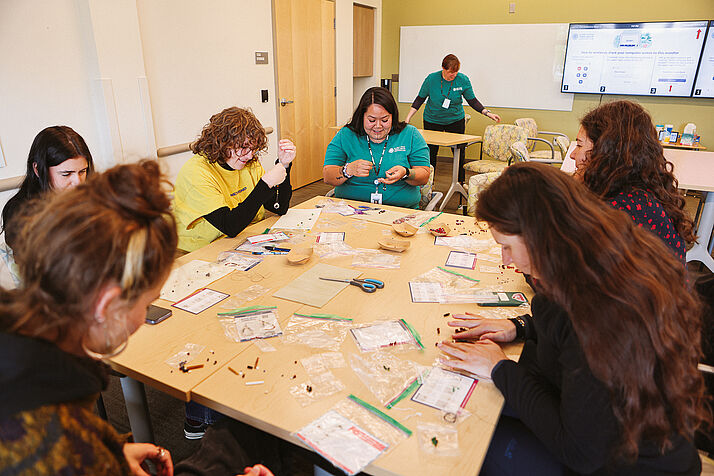
At the Alaska Native Tribal Health Consortium. Julia Elzea had an Interview with Amelia Simeonoff for her research regarding Traditional Healing practices. Amelia is a Sugpiaq artist - she organizes beading classes at the Alaska Native Tribal Health Consortium and invited the whole group to join one. We made earings together. A beautiful experience - we were so relaxed and calm after this visit.
© Julia Elzea

This is a textile artwork by artist Ree Nancarrow, whom I had the pleasure of interviewing during my time in Fairbanks. The piece is part of her A Sense of Place exhibition at Well Street Art Co. (May 2 – June 3, 2025) and explores themes of climate change and environmental transformation. Through layered fabrics and intricate stitching, Ree captures the fragility and resilience of Alaskan landscapes in a rapidly changing world.
© Federica Pescador

Community workshop in Fairbanks organized by ARCA, a project on biocultural heritage in Arctic cities
© Olga Povoroznyuk

Community workshop in Fairbanks organized by ARCA, a project on biocultural heritage in Arctic cities
© Vladimir Zhikhartsev
Die Stadt als umkämpftes Terrain – Aushandlungsprozesse im öffentlichen Raum
BA Studierende des Feldpraktikums „Die Stadt als umkämpftes Terrain – Aushandlungsprozesse im öffentlichen Raum“ beschäftigen sich im Wintersemester 2024/25 unter der Leitung von Sabrina Steindl-Kopf und Gabriele Habinger mit den gesellschaftlichen Aushandlungsprozessen, die den öffentlichen urbanen Raum prägen. So können Straßen, Plätze, Parkanlagen oder ganze Stadtgebiete als Orte gelesen werden, die Auskunft über herrschende Machtverhältnisse und hegemoniale Strukturen geben, ebenso über unterschiedliche Ausgrenzungs- und Aneignungsprozesse, wobei unterschiedliche soziale Kategorien zum Tragen kommen. Welche symbolischen Ausschlussmechanismen wirken, welche Formen des place-makings, des „Platz- und Sichtbarmachens", sind gleichzeitig zu finden?

Im Projekt „Catcalls Vienna“ untersuchten Studierende die Sichtbarmachung geschlechtsspezifischer Gewalt im öffentlichen Raum.
© Melissa Wagner

Welche Aushandlungsprozesse finden rund um die Nutzung des Grünen Praters statt und welche Auswirkung hat die Gestaltung der Freizeitflächen?
© Julia E. Elzea

Im „Atelier Machensachen“ untersuchten Studierende die Vergemeinschaftung von halböffentlichen Räumen und erprobten kreative Techniken.
© Mathias N. Psilinakis

Von Poetry Slam bis hin zu Mixed Art erforschten Studierende in der Brunnenpassage die Aushandlung von Diversität.
© Amelie Hochleitner

Im Wiener Westbahnhof untersuchten Studierende die Bedeutung von Sicherheitsdiskursen für Akteur*innen wie ÖBB, Polizei und Anrainer*innen.
© Anna-Katharina Kleinl

Der Zentralfriedhof in seinen vielfältigen Nutzungsformen – als Ort der Trauer, der Freizeit und des Tourismus – stand im Mittelpunkt dieses Projekts.
© Freya K. Greiß
Multispecies care: Researching more-than-human care schemes in Berlin
Under the supervision of Tatjana Thelen and Hilal Alkan Zeybek nine MA students spend three weeks in Berlin focusing on aspects around environment and care. Within this larger framework students will develop their individual research interest in small groups. Some topics might be offered by the teachers. During the preparation phase participating students were provided with examples from different fields (refugee reception, elderly care, childcare, prisons, migrant integration, and others) and encouraged to formulate their own interests and to choose the respective care settings.
- field stay: 24.11.–15.12.2024
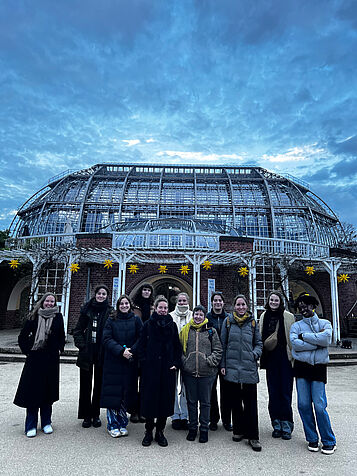
Unter der Leitung von Tatjana Thelen und Hilal Alkan verbrachten neun MA-Studierende im Rahmen des Feldpraktikums "Multispecies Care: Researching More-than-human Care Schemes" drei Wochen in Berlin, Deutschland.
© Anonym

Geführte Tour und Workshop mit Cornelia Ertl im Botanischen Garten Berlin.
© Hilal Alkan

Geführte Tour und Workshop mit Cornelia Ertl im Botanischen Garten Berlin.
© Hilal Alkan

I held a pigeon for the first time at Anja’s home, where I observed how she takes care of rescued pigeons as part of my research on Winter-pigeon feeding and care practices.
© Anonym

Group field visit at Domäne Dahlem with reflections on urban farms, local histories, boundaries between modern and traditional as well as constructions of nature.
© Hilal Alkan

This research at the "Freilichtmuseum Domäne Dahlem" is inquiring into the multiplicity of multispecies care in a place that acts both as museum, farm, and urban recreational space.
© Amelia Rimac

The project "Caring for the Living and the Dead: Multispecies ethnography in Berlin's Cemeteries" explores Berlin's cemeteries as spaces where care for the dead intertwines with ecological stewardship and community engagement. Through an ethnographic lens, it investigates how practices of maintenance, mourning, and biodiversity preservation create connections between the living, the deceased, and the natural world.
© Bianca Hennig
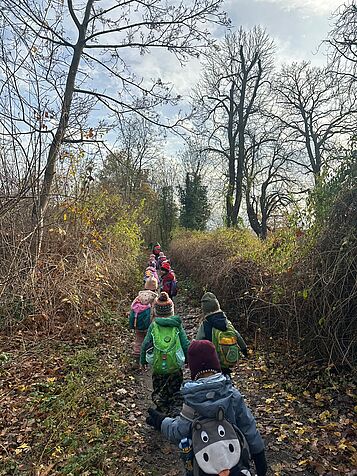
A forest school in Berlin where educators guide children in building confidence, and an understanding of coexistence with nature through embodied, multispecies interactions, highlighting the cultural mediation between urban and natural environments.
© Arzu Ertem

The research in the Viktoriapark Tiergehege deals with multispecies care, looking at how care in the form of a social project manifests in this microcosm as care work for the animals residing there.
© Bronte Lippens

The focus in my fieldwork has been on multispecies care in a cat cafe. What interests me is how animals and humans negotiate care in a commercial setting.
© Tuuli Heimonen

Visiting the Kinderbauernhof auf dem Görlitzer as a group and getting acquainted with the goats.
© Hilal Alkan
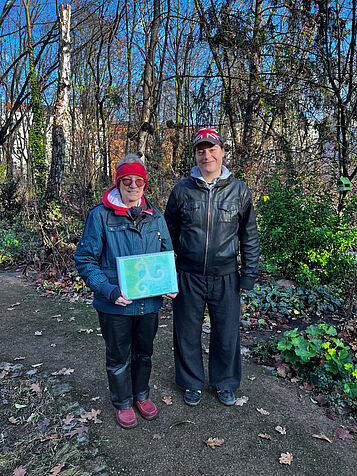
Clara with her colleague during a supervisory field visit at the lesbian cemetery area in Berlin, Prenzlauer Berg. Her colleague is holding the landscaping map after which the cemetery is built.
© Hilal Alkan

Giving Leni the sheep some scratches while cleaning the sheep enclosure. I am researching how the idea of care is being translated into action in the multispecies setting of an urban children's farm in Berlin Pankow.
© Anonym

Morning Routine. The chicken sand bath, located right at the donkey and pony stable at the heart of the children's farmyard in Görlitzer Park, serves as a cherished spot for chickens to practice "self-care" of feather hygiene. My research aims to explore how concepts of "Care" and "Nature" are taught and practiced within this farm setting, with a focus on identifying the roles of animals in this context.
© Theresia Caplie

The last evening in Berlin.
© Anonymous
Environment and Care in Galati (Romania)
Under the supervision of Tatjana Thelen and Stefan Dorondel, seven MA students spend three weeks in Galați, a city on the banks of the lower Danube in Romania. Drawing on current anthropological debates on care and more-than-human ethnography, the course participants developed research projects in advance. In the field, they learn and apply ethnographic methods to gain a deeper understanding of the social realities encountered and of ethnographic practice in general.
- field stay: 07.-27.05.2024

Under the supervision of Tatjana Thelen and Stefan Dorondel, seven MA students spend three weeks in Galați, Romania
© Wilma Jovell Swensson

Stefan explains to the group the ecological consequences of monocultural tree plantations and invasive species on the river banks of the Danube.
© Wilma Jovell Swensson

Jawon and her colleague are chatting while cleaning a cage. Her field is the municipal dog shelter of Galati, which currently houses over 1,000 dogs. Established 30 years ago with the goal of creating and manifesting a "clean city," it captures and protects dogs to clean up the streets. Jawon‘s research aims to understand how care is provided and which relationships are formed within the shelter, and how the hierarchy within the shelter is intertwined with these relationships.
© Tatjana Thelen

With around 1000 dogs at the municipal shelter, naming each one is nearly impossible. However, Sharon, a 10 months old Romanian Shepherd, stands out as the most beloved dog in the shelter, thanks to her delightful dogs-nality and breed.
© Jawon Cho

Jawon and her colleagues took a picture during their break time. The municipal dog shelter operates from 6 a.m. to 2 p.m. During breaks, colleagues usually gather together and hang out.
© Jawon Cho

Visiting the Zoo, the fieldsite of Martin, with one of his main interlocutors during work shifts. The project deals with more than human care in enclosures.
© Tatjana Thelen

My fieldwork focuses on the infrastructure of and around the Danube Promenade, Faleza, and what role it plays for the citizens of Galați. There are a lot of different ideas about how the nature around the Promenade should be kept. Some come to the space to escape the stress of the city, while others complain about how there’s nothing to do, and wish for more restaurants and less bushes. There’s one thing people seem to agree on though: the space has never been this clean before.
© Wilma Jovell Swensson

Yulia with one of her interlocutors, a long standing ecological activist against damage at the Danube" In the interview, she says: "European directives provided the tools to us to fight. Sometimes we won- sometimes we lost. Yeah. That`s how things are.”
© Stefan Dorondel

Joanna is serving the guests at the Social Center for the Elderly. Her project focuses on care in the context of the Catholic parish church in Galați.
© Joanna Haszcz

Anna Kokoba did fieldwork at an NGO that organizes school lessons for Ukrainian refugee children. The 15 children in this class study math, logic, and the arts, as well as the Romanian and Ukrainian languages. Her fieldwork focuses on how Ukrainian refugees are provided with care by various government and non-governments organizations.
© Anna Kokoba

This picture shows the art class activities of Ukrainian refugee children. Class activities include painting, singing and dancing.
© Anna Kokoba

Julia Petron’s fieldwork is in a special needs school with a focus on vocational courses in the culinary arts. During her time in the field, she focused on learning about care dynamics between students and teachers, as well as the multidimensional aspects of care experienced by teachers as caregivers to their students.
© Julia Petron

Julia and her guiding teacher in front of the school building.
© Julia Petron
Urban Elements
After some weeks of intensive readings and methodological preparations, 16 Master students set out to Madrid under the supervision of Janina Kehr and Mafe Olarte Sierra to practice ethnographic skills on the topic of Urban Elements between April 27 and June 17th 2024. Following one of five elements in the city (water, air, fire, earth and love), students were asked to find a graspable research topic, where questions of urban habitability and living together are at stake. While the pursuit of own research projects is the focus of the fieldcourse, we also enjoy meeting local scholars to get insights into the diverse landscape of anthropological and urban related research in Spain.
- field stay: 28.04.-18.05.2024

Weekly plenary meeting in the Cultural Centre "El Matadero" (Taylor Dubé, Olivio Tentori, Sofia Zuñiga, Yolanda Oyuela, Clemens Lafenthaler, Angelo Alario, Lena Mittendorfer, Marie Kindler, Chanakhan Khankratok, Ekaterina Straikova, Kseniia Naidenova, Jonathan Rickelt, Nora Pearce, Janina Kehr, Camilla Venara, Kennia Baduy, Belén Sanchez)
© Janina Kehr

Walking Tour on the rehabilitation of the Rio Manzanares with urbanist Malú Cayetano
© Janina Kehr

Mercado de Los Mostenses in Madrid, captured on a sunny afternoon, after the morning rush has calmed. This bustling market, central to my project 'Community at the Table,' is a hub for Peruvian businesses, offering a vibrant glimpse into the role of food within Latin American communities in Madrid.
© Jonathan Rickelt

Gazing from the Montaña Artificial in Parque del Retiro, Madrid, one can witness the beauty of the Casita del Pescador. In this specific area, I delve into the study of caregivers' interventions with the elderly, exploring the essence of care within this public space. It is a place where memory meets present-day attention, shedding light on the significance of caregiving in our broader society.
© Belén Sánchez Vilar

My colleague Clemens Lafenthaler and I are working with the neighbourhood initiative and urban community garden "Esta es una Plaza" in the Lavapiéz neighbourhood of Madrid. The initiative grew out of a two-week workshop on revitalising abandoned spaces and has resulted in a self-managed, sustainable urban garden with vegetable plots, composting stations, a children's area and an amphitheatre for assemblies (all self-made from used materials) that is open to everyone to enjoy nature and to socialise with other neighbours or visitors.
My research interest focuses on how neighbours debate, imagine and create alternative ways of organising social life in the neighbourhood by caring for and about nature and each other whilst organising and managing the community garden together.
© Marie Kindler

In the project I collaborate with my colleague Marie Kindler. Our common research fieldsite is a community garden/neighborhood association called "Esta es una plaza" located in the Lavapiés neighborhood of Madrid. In the context of this space, I am interested in how community members take care of both their social and ecological environments through various practices such as urban gardening, community gatherings and socially engaged projects. I want to find out how people united in an “urban commons” project develop a sense of reciprocity which is shaped by human interdependence and eco-dependence with nature. In what ways do the community members give and receive different forms of care? What do these care practices look like? How do members perceive their caring relations with others?
© Clemens Lafenthaler

The city of Madrid has long been and still is a prominent center for street art, a realm often associated with a male-dominated narrative. However, in recent years, there has been a notable integration of feminist and queer perspectives within Madrid's street art scene, challenging traditional stereotypes. In my research, I adopt a queer-feminist lens to examine the role of street art in shaping public space and fostering novel realms of expression, care, and community within Madrid's urban landscape. In collaboration with local street art artists and community members, the aim is to ascertain the impact of these newly crafted spaces on the well-being of neighborhoods, with a particular focus on the experiences of queer-feminist communities.
© Lena Mittendorfer

In April 2018, Calle del General Millán Astray, named for a Francoist General, was renamed to Calle de la Maestra Justa Freire, a teacher who in recent years has been dubbed a pioneer of popular education in Madrid. By August 2021 the street was reverted back to Calle del General Millán Astray. Today, you can find a mural dedicated to Justa Freire, signs all along the street calling for "El nombre digno para esta calle" ["The dignified name for this street"] and other forms of contestation. Likewise, the mural and signs in support of naming the street Justa Freire are also contested through vandalism. Using this street as a case study, the research will explore contested space, and how collective memory is both a tool and mirror, to ask: How do residents and activists embrace, negotiate, or reject the collective memory expressed through the naming of a street?
The image in this blog was created by me using 2 photos that I took at the fieldsite (the current street name & the mural for Justa Freire which can also be found on the street). This image is meant to express the contestation of memory.
© Taylor Dubé

Located at the Plaza de Cibeles -- arguably Madrid's most emblematic plaza -- Nora Carolina Pearce is conducting ethnographic fieldwork on place-making and how urban spaces of power are shaped and re-shaped by the people who inhabit it on a regular basis.
The plaza itself is designed for people to move through it and to not linger for long, perhaps only stopping to take a photo of the iconic Fountain of Cibeles and City Hall. The people who work at the plaza, like at the kiosks or public transportation stands, therefore play a key role in inhabiting and shaping the space, yet they are often overlooked by popular narratives told of the Plaza de Cibeles.
© Nora Pearce

Puente de Vallecas, Sector Portazgo. Performing an ethnography of okupas (evicted) in the zone.
On the picture, behind the metro stop at the entrance of the building, next to the foreign affairs attorney services sign, some people were moving out because of foreclosure by the bank, they lost the case after years. How do I know? I had an informal conversation with them just passing by. Apparently someone from an organization (PAH) helped this couple to find a new place so they said.
© Angelo Alario
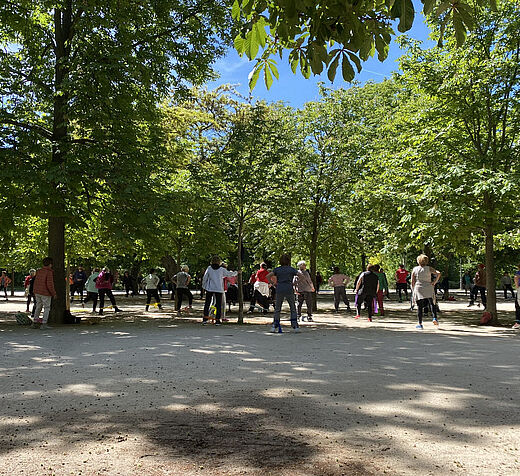
I am studying the different perspectives of the “Enforma” project at the Retiro Park in Madrid as a social intervention of a public space, in particular how the elderly people make use of the park as a way of socializing, staying active and avoid solitude, as well as the conflicts arising from this governmental project.
© Sofie Jimena Zuñiga Llop

The exercise of walking through El Retiro Park together with its regular users while listening to the memories and imaginaries that places evoke in them as a way of understanding how people create a sense of belonging and community in public spaces... (picture 1/2)
(translated with DeepL)
[original text: El ejercicio de caminar a través del Parque de El Retiro junto con sus habituales usuarios al mismo tiempo que escuchamos las memorias y los imaginarios que los lugares evocan en ellos como forma de entender cómo las personas crean un sentido de pertenencia y comunidad en espacios públicos.]
© Kennia Asenet Baduy Valdez

... The photos I share here, are the elf that some remember from the stories they were told as children, thanks to him the park was full of flowers. While the tree represents how from a personal imaginary something tangible and present was achieved. (picture 2/2)
(translated with DeepL)
[original text: Las fotos que aquí comparto, son el duende que algunos recuerdan de las historias que les contaban de niños, gracias a él el parque estaba lleno de flores. Mientras que el árbol representa como a partir de un imaginario personal se logró algo tangible y presente.]
© Kennia Asenet Baduy Valdez

Kseniia Naidenova, Ekaterina Straikova and Chanakhan Khankratok conduct research on Sala Equis, an old cinema that turned into a bar/cinema while still maintaining its original architectural structure, giving people a different nightlife experience. The transformation of the place can contribute to nightlife economy in Madrid, claiming to be a space that people from different places can socialize.
© Chanakhan Khankratok
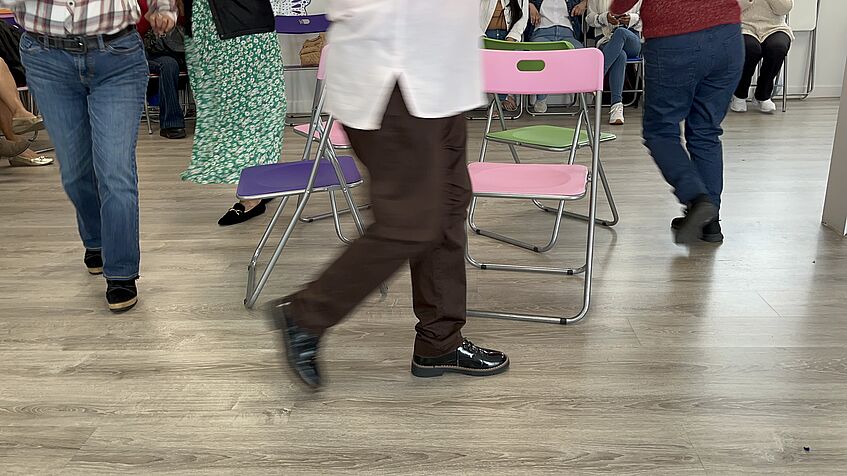
In collaboration with the Centro de Empoderamiento de las Trabajadoras del Hogar y los Cuidados (Center for the Empowerment of Domestic and Care Workers), this research critically looks at care work as the principal gateway to the Spanish labor market, particularly for Latin American women who have migrated (mujeres migradas). This research project aims to identify how the center helps the women navigate a sector of invisibility, vulnerability, and irregularity by empowering them through community building and the dissemination of pertinent information, fostering their agency and resilience within the labor market.
© Yolanda Jimena Oyuela Flores

My research focuses on ESLA EKO, a self-managed squatted social center located in the district of Carabanchel. This center was established during the 15M movement, that is why they operate with a horizontal hierarchy system. ESLA EKO provides an inclusive space for all members of the community. Here, individuals can engage in a variety of activities, supporting creativity and experiences. Through my research, I aim to explore how ESLA EKO and its diverse range of activities contribute to foster social cohesion among its participants.
Website: eslaeko.net/e-s-l-a-eko/
© Olivio Tentori Montalto

I am investigating the Bosque Metropolitano of Madrid, one of the best urban reforestation projects being developed throughout Europe. I will analyse how the urban social fabric is shaped by the Bosque Metropolitano considering aspects such as climate change mitigation, biodiversity, human health and social welfare.
© Camilla Venara
Neue Wege des Ethnographischen Sammelns und Ausstellens
Nach einem Vorbereitungsseminar im Wintersemester 2022/23, findet im Sommersemester 2023 unter der Leitung von Sanda Üllen und Igor Eberhard und Teilnahme von 20 Studierenden das eigentliche Feldpraktikum statt, in dem es um die Konzeption, Planung und Umsetzung einer Ausstellung geht. Dabei sind die Studierenden von der Ideenfindung über die Finanzierung, Verfassen von Texten, Auswahl der auszustellenden Objekte, Gestaltung der Ausstellung bis zu deren Eröffnung und Langzeitarchivierung der Ergebnisse voll involviert.
Die Studierenden entscheiden sich die Ausstellung unter dem Titel "Lost in Gender" zu kuratieren. Die Präsentation von Sammlungsobjekten des anthropologischen Instituts sowie von aktuellen Fotografien und Alltagsobjekten dient der kritischen Auseinandersetzung mit der Geschlechterbinarität. Thematisiert werden das kolonialistische Überstülpen von Zweigeschlechtlichkeit auf außereuropäische Kulturen sowie aktuelle queerer Realitäten.
- Die Ausstellung konnte von 15.09.-12.10.2023 im Sitzungszimmer des Instituts besichtigt werden
- Webseite der Ausstellung: https://exhibition-guide-to-gender.earth/

Im Sommersemester 2023 beginnt das Brainstorming für die Ausstellung.

Welche Objekte in der Ausstellung zu sehen sein werden, muss sorgfältig überlegt werden.

In den Sommermonaten wird die Ausstellung dann aufgebaut.

Die Ausstellungsbesucher:in erhält Einblicke in einen von Außerirdischen verfassten Expeditionsbericht, der die Lücken, die koloniale Forschungsreisen und gesellschaftliche Normierungen hinterlassen haben, anfängt zu füllen...

... Statt zu Verallgemeinern, lassen sich die Entdecker:innen von der anfänglichen Konfrontation mit einer strikten Unterscheidung in zwei getrennte Geschlechter nicht irritieren, sondern beginnen eine akribische Arbeit, die in der Entdeckung der größeren Vielfalt an Geschlechtermodellen unter den Erdbewohnern mündet.

Am 15.09.2023 wird die Ausstellung feierlich eröffnet.
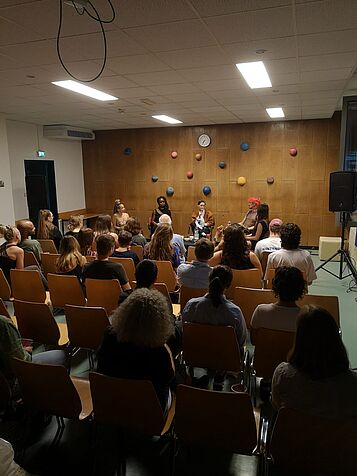
Auf die Eröffnungsrede folgt eine Podiumsdiskussion über die aktuelle Situation und Lebensrealität queerer Personen.

In den folgenden Wochen bieten die Studierenden regelmäßige Führungen durch die Ausstellung an.
Naturwahrnehmung um den Nationalpark Neusiedler See - Seewinkel
In zwei Aufenthalten Ende März und Anfang Juni 2023 verbringen fünf MA-Studierende mit den LV-Leiter*innen Franz Graf und Gertraud Seiser drei Wochen um und im Nationalpark Neusiedler See – Seewinkel.
Während des ersten Aufenthalts standen das Kennenlernen der Region, ihrer Institutionen und intensive Gespräche mit Expert*innen im Vordergrund. Zwischen den Feldaufenthalten entwickeln die Studierenden kooperativ, aber voneinander unabhängig Kleinprojekte, in deren Zentrum die Wahrnehmung von Natur durch verschiedene Akteur*innengruppen steht. Dazu wurden im zweiten Feldaufenthalt die empirischen Erhebungen durchgeführt.
- Feldaufenthalt 1: 26.03.-02.04.2023
- Feldaufenthalt 2: 29.05.-12.06.2023
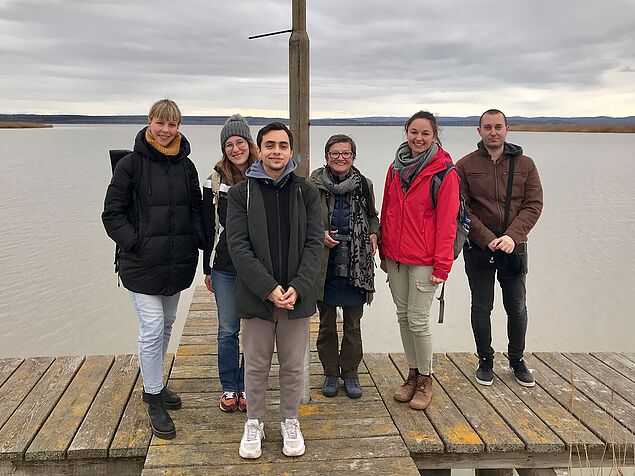
Tirza Stock, Magdalena Langheiter, Vadym Yeremiichuk, Gertraud Seiser, Marica Zvonarits und Nikola Blagojevic am Steg der Biologischen Station Illmitz nach einer Führung durch die Biologische Station (durch Gilbert Hafner) und einem Gespräch über mögliche Folgekooperationen mit Thomas Zechmeister.
© Franz Graf

Die Region Seewinkel kann nicht verstanden werden, ohne das Schilfrohr bzw. den Schilfgürtel in die Forschung miteinzubeziehen. Schilfrohr bildet ausgeprägte Monokulturen, die jedoch in ihrem Alter und Struktur vielfältig sind. Schilf hat viele Erscheinungsformen, was dazu führt, dass Menschen mit Schilfbeständen unterschiedlich umgehen.
Magdalena Langheiter hat sich im Zuge des zweiten Feldaufenhalts mit der heterogenen Wahrnehmung von Schilf durch verschiedene Akteur*innengruppen im Seewinkel auseinandergesetzt. Dabei wurde nicht nur die Perspektive des Nationalparks Neusiedler See, sondern auch die der Feuerwehr Illmitz und die zweier Schilfschneider miteinbezogen.
© Magdalena Langheiter

Im Zuge der Forschung wurde deutlich, dass Schilf nicht immer gleich aussieht und sich auch sein Nutzen verändert. Das Bild zeigt grünes und frisches Jungschilf. Nach einem Jahr Wachstum wird es dann einjähriges Schilf genannt. Dieses kann in einzelnen Gebieten rund um den Neusiedlersee von Schilfschneidern im Winter geerntet und im nächsten Schritt weiterverarbeitet werden.
© Magdalena Langheiter

Dieses Bild hingegen zeigt das sogenannte Knickschilf. Wird Schilf älter, dann verändert sich seine Farbe und seine Struktur. Schilf wird bräunlich und knickt um. Bei Knickschilf handelt es sich um einen wichtigen Lebensraum, der von vielen Vogelarten rund um den Neusiedlersee genutzt wird. Knicken die Schilfhalme zu sehr ineinander entstehen dichte Schilfmatten und es bildet sich das sogenannte Bruchschilf. Problematisch bei diesem Altschilfbestand ist, dass einerseits Jungschilf durch die dichten Schilfmatten nicht mehr hindurchwachsen kann und andererseits keine Vögel dort brüten. Erst durch das genaue Hinschauen wird wahrnehmbar, dass Schilf nicht gleich Schilf ist.
© Magdalena Langheiter

Ende März stehen wir (im Bildvordergrund Nikola Blagojevic und Franz Graf) im Schneesturm an der Brücke von Andau. Dieser nun offene Grenzübergang wurde nach 1956 zum Symbol für die Flucht aus autoritären Regimen und verweist auf den Seewinkel als einen Hotspot für Flucht und Migration.
Die Erkundungen, Eindrücke und Gespräche mit Expert*innen während des ersten Feldaufenthalts regten die Studierenden zu ihren individuellen Projekten an.
© Gertraud Seiser
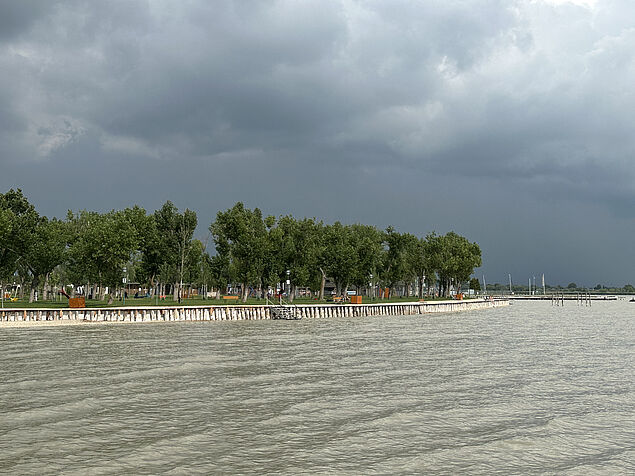
Nicht nur als Urlaubs- und Erholungsregion ist das Burgenland innerhalb von Österreich bekannt. Mediale Aufmerksamkeit haben auch immer wieder dramatische Fluchtereignisse erregt. Als Grenzregion Richtung Osten hat der Seewinkel hierbei eine besondere Position inne. Tirza Stock interessiert sich im Rahmen des Feldpraktikums für die Perspektiven von Geflüchteten, die ihren Lebensmittelpunkt um den Neusiedlersee herum haben. Wie sehen ihre Alltagsrealitäten aus? Wie erfahren sie in ihrer Umgebung die Natur? Welche Relevanz hat diese in ihrem Leben? In den Interviews mit Geflüchteten zum Thema Natur sind neben der persönlichen Migrationsgeschichte
auch Vorstellungen von Heimat, Familie und Religion zum Vorschein gekommen.
© Vadym Yeremiichuk
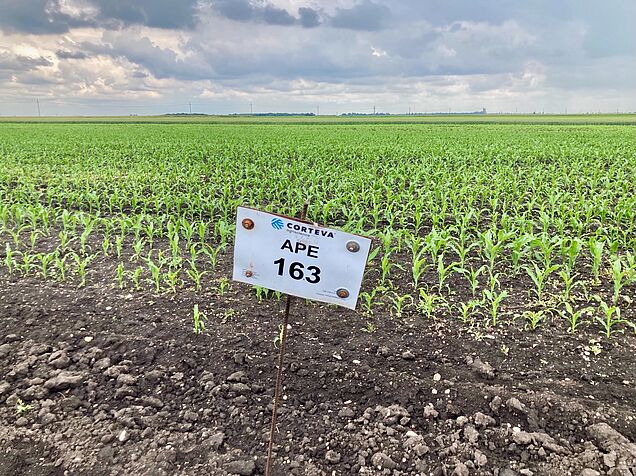
Das ist ein Acker – genauer gesagt ist es ein Saatgutmaisacker -, welcher im Seewinkel bewässert wird. Der Seewinkel hat in den letzten Jahren neue Grundwassertiefpunkte erreicht. Gründe dafür sind zum einem der Klimawandel mit den immer länger werdenden Trockenperioden und zum anderen anthropogene Eingriffe in den Wasserhaushalt des „Feuchtgebietes“. Mittels zahlreicher Entwässerungs- und Bewässerungssysteme wird Grundwasser in der Region entnommen, was inzwischen nicht nur lokal hinterfragt wird. Dabei ist der Diskurs um die Infrastruktur Wasser emotional geladen. Marica Zvonarits beschäftigt sich mit zwei Betrieben in Illmitz, die ihre Kulturen bewässern. Sie interessiert sich dabei dafür, wie diese Landwirt*innen in dieser wasserknappen Region Wasser und den Umgang damit wahrnehmen.
© Marica Zvonarits

Während des Feldpraktikums im Nationalpark Neusiedler See-Seewinkel untersuchte Vadym Yeremiichuk die komplexen Zusammenhänge zwischen Tourismus, Nachhaltigkeit und der lokalen Naturwahrnehmung. Durch Interviews mit wichtigen Stakeholdern, u.a. Tourismusmanagern, dem Bürgermeister von Illmitz und der Bürgermeisterin von Podersdorf sowie einem Vertreter des Nationalparks, versuchte er, ein Verständnis für die Aushandlungsprozesse zwischen touristischen Ansprüchen und den politisch-ökologischen Bedingungen des Umweltschutzes zu entwickeln. Seine Recherche ergab, dass es viele Herausforderungen gibt, von der Vereinbarkeit unterschiedlicher Perspektiven bis hin zur Umsetzung nachhaltiger Praktiken. Diese können nur im Kontext einer Sehnsucht nach einer tiefen Verbundenheit mit der Heimat und der Hoffnung auf eine harmonische Zukunft verstanden werden. Darüber hinaus beleuchtet seine Arbeit nicht nur die komplexen Dynamiken rund um den Nationalpark Neusiedler See-Seewinkel, sondern verdeutlicht auch das Potenzial eines anthropologischen Zugangs bei der Erforschung der Nuancen von Mensch-Umwelt-Beziehungen.
Die Fotos (© Vadym Yeremiichuk) zeigen wichtige touristische Punkte: 1 - Strandbad in Illmitz, 2 - Strandbad in Podersdorf am See, 3 - Der Leuchtturm von Podersdorf, 4 - Weiße Esel in Sandeck - Neudegg bei Illmitz, 5 und 6 - Aussichtsturm am Rande der Graurinderkoppel im Seevorgelände.

Während eines Feldpraktikums spielen gemeinsame Mahlzeiten eine besondere Rolle. Studierende und Lehrende sitzen am Tisch zusammen, teilen ihre Gedanken, Erfahrungen und Ideen und erweitern ihr Verständnis durch den Dialog. Eine grundlegende Dynamik anthropologischer Praxis.
© Franz Graf

In his digital ethnography project, Nikola Blagojevic explores the narratives and stories of Burgenland Bunch members regarding their connection to the nature and environment of Burgenland. The Burgenland Bunch is a history and genealogy group focused on developing genealogical data concerning Burgenland emigrants and assisting individuals of Burgenland descent in tracing their ancestral heritage. Notably, a significant number of Burgenland Bunch members are descendants of Burgenland emigrants who settled in the United States, and they maintain a link to the region’s environment through stories passed down by their ancestors and personal experiences.
© Nikola Blagojevic
Field School in Indonesia: Civil Society Organisations in Java
Im Sommersemester 2023 verbringen 8 MA-Student*innen unter der Leitung von Gabriele Weichart drei Wochen in Java, Indonesien.
Gemeinsam mit Student*innen der Universitas Gadjah Mada in Yogyakarta arbeiten sie in verschiedenen Bereichen um die Sturkturen und Arbeit unterschiedlicher NGOs zu erforschen.
- Feldaufenthalt: 01-26.05.2023
- Instagram Account: @javanthropics

The Field School in Indonesia started with a visit to the Anthropology Department at Gadjah Mada University in Yogyakarta because students from both universities will collaborate in their research. Each group of students will be based with one local NGO and focus on one particular topic that ranges from gender-based violence to the environmental issues, from eco-tourism to traditional and contemporary arts and crafts.
© Gabriele Weichart

Sophia Sternath has started working with Eco Enzyme which is an Indonesian NGO that, among other places, operates in Kulon Progo in the Special Region of Yogyakarta. The aim is to use fermentation processes to produce cleaning products, medical products and personal hygiene products from organic waste, but also fertilizers and agents for air and water purification. Apart from that, a lot of emphasis is also placed on education by offering local children the opportunity to use the library on Sundays to read or to take part in workshops.
© Sophia Sternath

Trying to do fieldwork without prior team meetings is like trying to cook gourmet Nasi Goreng without a recipe - you might end up with a hot mess instead of hot data! ARuPA (Alliance of Volunteers to Save Nature) is an Indonesian NGO engaged in the preservation of natural resources and the environment. It was formed in 1998 in Yogyakarta by several students and young alumni of the Faculty of Forestry, Gajah Mada University. Their work is based on the vision of an economically-socially-politically empowered civil society: to realize fair, sustainable, democratic and sustainable management of natural resources and the environment; towards the achievement of community welfare. The mission is to empower forest communities by creating a sustainable system for community-based forest resource management, achieved by conducting studies, strengthening local institutions, and providing community assistance. Kajetan Moro will be working with ARuPA over the next few weeks.
© Kajetan Moro

Rifka Annisa is an organisation that is fighting against gender-based violence. They host women‘s shelters in Yogyakarta, educate communities around sexual harassment and domestic violence, council survivors and advocate for gender equity in Indonesia. They also have a social media channel that you should check out where they inform around gender issues, women’s rights and violence. Anna Lena has started her research with this organisation.
© Anna Lena Seidel

This is Bettie Kirsch with a traditional Javanese rice husker called "lesung", used throughout Java by Indonesian rice farmers. Today it serves as a bench in JAVLEC's office.
JAVLEC is a non-profit organization that promotes forest conservation and social forestry and is active in many parts of Indonesia. Their goal is to support civil society organizations (CSOs) to improve natural resource management in local communities.
One of these projects is in Kalibiru, a small forest village in the Special Region of Yogyakarta that has reclaimed its exploited forest. It is now a protected area. To create new jobs outside the timber business, the community began building a well-known ecotourism sight in the forest. Although local tourism was affected by the pandemic, Kalibiru is now striving to regain its former popularity.
© Bettie Kirsch

In Indonesia, waste management is a pressing issue, with challenges such as inadequate infrastructure, limited recycling practices, and the improper disposal of waste. This leads to environmental pollution, health risks, and the depletion of valuable resources. During my fieldwork, I learned firsthand how Monumen Antroposen is demanding a transformative shift from society. The project engaged with the local community, and it became evident that the monument serves as a catalyst for change. It challenges the prevailing attitudes towards waste management and calls for a collective transformation in how we perceive and handle waste. Monumen Antroposen draws attention. We need to think about waste as not only a problem of nature as a physical entity but also about the social environment of certain neighborhoods, Therefore. Monumen Antropsen adopts a collaborative approach on sustainable practices, and contributes to the creation of a more environmentally conscious society.
© Aysel Aycan Aktaş
Wasserwelten Philippinen - Österreich
Im Jänner 2023 verbringen 6 MA-Studierende unter der Leitung von Bernhard Hadolt ein knappes Monat auf den Philippinen. Dabei liegt der Forschungsfokus auf sozialen Phänomenen, Praktiken und Bedeutungen von Trink- und Brauchwasser, wie sie sich auf den Philippinen und Österreich aus komparatistischer Perspektive manifestieren.
Lea Nobel gibt Einblick in ihr individuelles Forschungsprojekt.
- Feldaufenthalt: 03.-31.01.2023
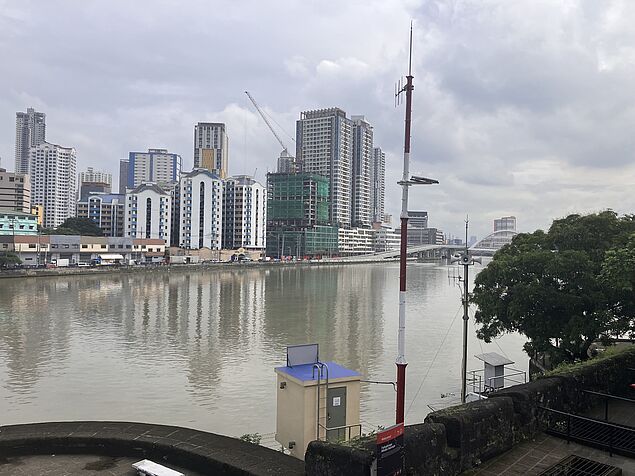
A photo of rainy Manila. The overall theme of the seminar was "Anthropology of Water": As it was very rainy during our stay, we found a lot of water – and rain is one of the most precious kinds of water of all. Each of us worked on an individual research project, applying anthropological research methods in practice. Interestingly, through our individual research, we all found a project connected to the many distinctions in water: drinking water, sea water, well water, or dirt water.
© Lea Nobel

Part of our group was doing research on Apo Island: Since there is electricity only between 6PM and 10PM it was the perfect place to study handwashing, as a washing machine does not make sense under these circumstances. Here we are standing close to a well, which is central to the village. It was an interesting place to start the research on the island, as a lot of locals got their water supplies from it or washed pieces of clothing close to the well.
© Lea Nobel

My personal research project was connected to the role of handwashing the laundry – here I am doing my own laundry. The practice of washing is very important in the Philippines. Hand washing is generally widespread, especially in private households (i.e. not necessarily in laundromats, where washing machines are used due to the heavy workload).
© Lea Nobel

One of the main findings was that hand washing is generally considered cleaner than the washing machine. Often the higher cleanliness was explained by the fact that hand washing means that specific dirty spots are washed, while the washing machine only "turns in circles". Here, one of my informants prepares the various ‘basins’ needed for the washing process later.
© Lea Nobel
